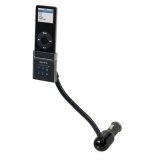
There are a couple different options. The most common and easiest is to run is an FM modulator. For those who are not familiar with the process of FM modulation, the signal is transferred from the analog output into a radio frequency that is picked up by your radio’s tuner on a specific channel. There is a selection of stations to choose from to in case there are radio stations already use.
They make a few different modulators one of which is the Griffin iTrip that connects directly into the upper or lower docking plug on your iPod depending on the model. I have found this unit to have an undesirable amount of static and poor signal to noise ratio causing you to turn your volume up higher with a larger amount of distortion. Distortion is the enemy of a speaker. Too much distortion causes a heat build up which causes the voice coil in the speaker to expand exponentially, when your voice coil expands too much it literally fries and ultimately breaks.
The other model you will come across Belkin F8Z063 that holsters your iPod and plugs into you 12 volt auxiliary plug (cigarette lighter) and acquires the signal from the bottom docking plug. This signal is transmitted in a similar fashion as the unit mentioned above and works much better. There is much less distortion (almost none) and the static is nearly eliminated. There are a few reasons for this: it's a better power source and has a better signal strength because it uses the constant power from the car as oppose to the battery in the iPod not to mention it keeps your iPod from flying through your car on turns or acceleration.
MP3 Players however will incorporate into your system in a similar fashion. There is a very wide selection of products, many of which follow the same technology as the iPod. However most will not harness its power from the MP3 player instead this type of FM modulator gets its power from the cigarette lighter and much like the iTrip emmits a signal which your radio tuner picks up.
The is yet another way of FM modulation. That is to use RCA style output plugs from the headphone output and plug that wire into a Universal FM modulator. Soundkase makes a nice unit which eliminats the static from emission. It is a direct in line mdulator that works in the same fashion as the others listed above. In order for this to work you must make a few power connections and may possibly need antenna adapters for many newer cars. But if you must FM modulate this is by far the best way to go.
The other option that I have found to be much more effective is the use of the auxiliary input on your radio. The high quality can be attributed to a wider frequency band and the use of one converter. Many aftermarket units have an RCA input in the rear of the deck. As drivers have become more and more focused on having gadgets and gizmos in their new cars, auto manufacturers have been incorporating an auxiliary input into their radios. Most of the time they use a 1/8th inch stereo (same plug as on your iPods’ ear buds) plug in the front of the radio. Some radio manufacturers such as JVC have incorporated a unit that will connect to your JVC head unit AND to your iPod.



